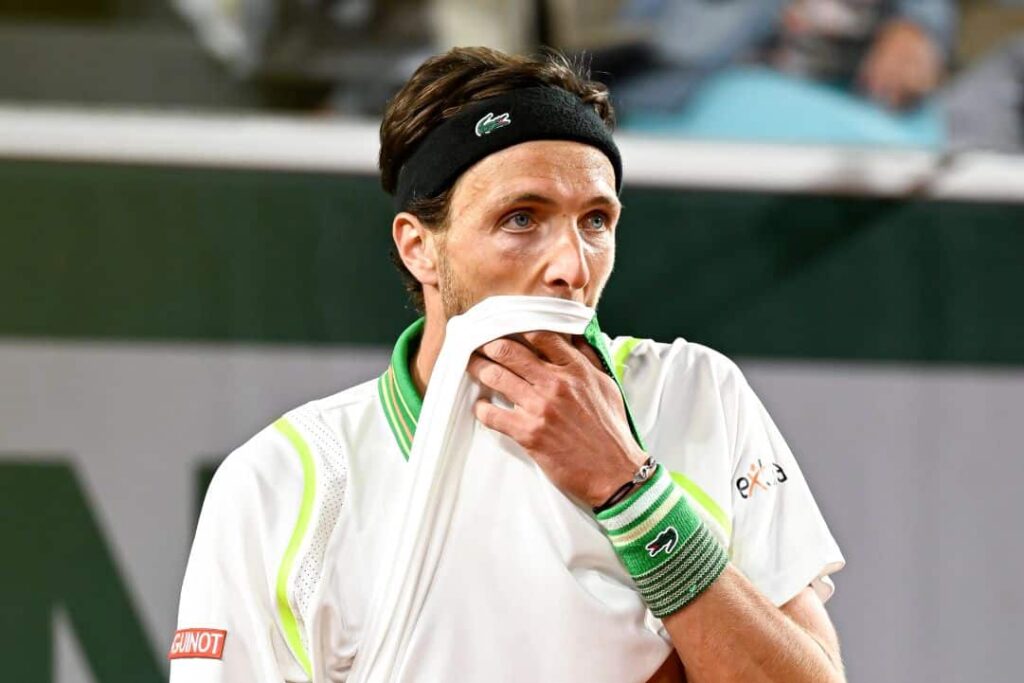
French tennis player Arthur Rinderknech, ranked 70th in the ATP, suffered a collapse due to intense heat during his match against Canadian Felix Auger-Aliassime at the Cincinnati Masters 1000 on Monday, August 11, 2025. The incident occurred in the second set, with temperatures reaching 32°C and a heat index of 35°C, leading to the player’s withdrawal after two hours of play. The episode reignited criticism about holding matches during peak heat hours, raising concerns about athlete safety. Rinderknech, who had previously defeated Casper Ruud, attempted to continue but could not withstand the extreme conditions.
The match, which began at 11 a.m. local time, was competitive, with Auger-Aliassime winning the first set in a tiebreak. After showing signs of exhaustion, Rinderknech collapsed on the court’s sideline, receiving immediate medical attention. The tournament staff provided cold water and ice packs, but the visibly shaken Frenchman retired at a score of 7-6 (4), 4-2.
The Cincinnati Masters 1000, held in Ohio, has faced scrutiny due to high temperatures, particularly in daytime matches. Other players, like Daniil Medvedev, have also struggled with similar conditions, fueling debate about adjusting schedules and improving safety measures.
The moment Rinderknech fell sparked immediate concern. The chair umpire, Peruvian Jimmy Pinoargote, quickly noticed the issue and called for medical assistance. Felix Auger-Aliassime crossed the court to check on his opponent, showing solidarity. The crowd, initially stunned, applauded Rinderknech’s effort to continue.
Medical staff acted swiftly, providing water, cold towels, and ice packs. Despite their efforts, Rinderknech struggled to breathe and maintain balance, clear signs of heatstroke. After briefly attempting to resume, he lost his serve and retired at 4-2.
The heat in Cincinnati has been a persistent challenge for players. With temperatures above 30°C and high humidity, the tournament tests athletes’ physical endurance. On Sunday, Daniil Medvedev, former world number one, drew attention by using a cooler to relieve heat during his loss to Adam Walton. The viral image of Medvedev with his head in a cooler underscored the severity of the conditions.
The choice of daytime match schedules has drawn criticism from players and experts. In 2023, Medvedev had warned about the dangers of extreme heat at the US Open, noting potential serious consequences. Rinderknech’s case reinforces the need for preventive measures, such as longer breaks or night matches.
The Cincinnati tournament, a key preparation for the US Open, demands high physical performance, but weather conditions have compromised players’ health and performance.
Heat-related collapses are not new in professional tennis. In summer tournaments like the Australian Open and US Open, players often face harsh conditions. In 2018, during the US Open, Novak Djokovic and others criticized the lack of hydration breaks on hot days. Cincinnati’s recurring heat issues, exacerbated by its August timing, highlight the need for stricter protocols.
Rinderknech, coming off a strong win against Casper Ruud, showed resilience by attempting to continue, but the incident underscores the need for consistent heat policies. The ATP has implemented rules like a 10-minute break in extreme conditions, but their application remains inconsistent.
The debate over heat in tennis grows with each incident, pressuring organizers to rethink tournament planning.
Rinderknech’s withdrawal secured Felix Auger-Aliassime’s spot in the Cincinnati Masters 1000 round of 16. The Canadian, ranked 28th, now awaits the winner of Stefanos Tsitsipas versus Benjamin Bonzi. Despite the win, Auger-Aliassime expressed concern for his opponent’s health, emphasizing the incident’s severity.
For Rinderknech, the focus shifts to recovery. The Frenchman, who performed well against Ruud, will undergo medical evaluations to assess any lasting effects of the heatstroke. The incident may affect his preparation for the US Open, starting late August.
The incident further fuels discussions about athlete safety in high-stakes tournaments with demanding schedules.
The ATP and tournament organizers have explored ways to protect players in extreme weather. Measures include extended breaks, access to cooling areas, and constant temperature monitoring. However, their application varies, prompting criticism.
Players like Rafael Nadal and Carlos Alcaraz have advocated for changes, such as fewer daytime matches on hot days. Technologies like body temperature sensors and monitored hydration are being tested in some events.
Athlete safety remains a priority, especially in a sport requiring intense physical performance over long matches.
Após um mês afastado por lesão, o meia uruguaio Nicolás De la Cruz voltou aos…
Guillermo del Toro, the acclaimed Mexican filmmaker and Oscar winner for The Shape of Water,…
Guillermo del Toro, renomado cineasta mexicano vencedor do Oscar por A Forma da Água, traz…
A Seleção Brasileira se prepara para os confrontos contra Chile e Bolívia, marcados para 4…
A Seleção Brasileira se prepara para os confrontos decisivos contra Chile e Bolívia, marcados para…
Bruna Marquezine e Danilo Mesquita vivem romance após química em série, revela Leo Dias na…